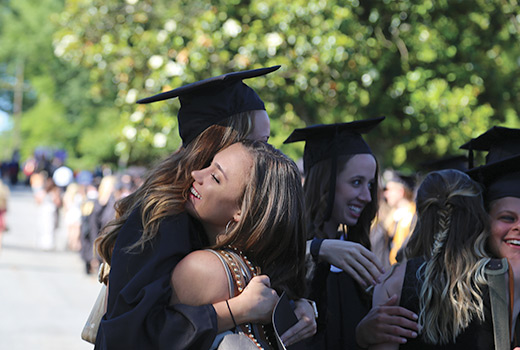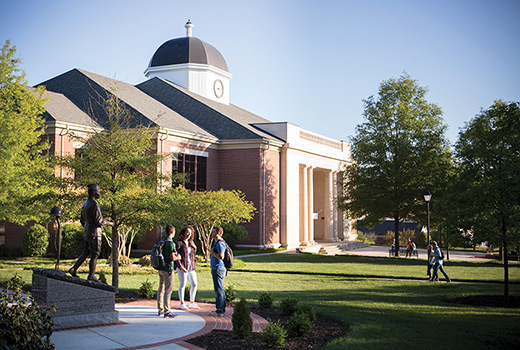South Carolina Baptists enjoy a close affiliation with three healthy and growing universities, each distinct, but each firmly grounded in the mission of offering a Christ-centered higher education for all their students.
They came into being at different times in history — Anderson University tracing its roots to a pre-Civil War women’s seminary; Charleston Southern University, the youngest of the three schools, coming into existence only 60 years ago; and North Greenville University, founded as a high school at the end of the 19th century by a local Baptist association that understood the importance of educating the children of rural northern Greenville County.
Each school has evolved along the way — two of them transitioning from junior college to four-year-college status in the latter part of the 20th century — to become full-fledged universities offering myriad academic options and post-graduate degrees. In the last decade, all three schools have put into place academic offerings to provide home-grown training for tomorrow’s pastors, religious scholars and worship leaders. As the higher-education landscape has changed, particularly in religious instruction and ministry preparation, South Carolina’s three Baptist universities have risen to the challenge.
Today, all three universities’ student populations are bursting at the seams, and their drawing boards are filled with plans to accommodate future growth.
Anderson University’s identity with South Carolina Baptists goes back well before its founding, tracing its origin to one of the first institutions of higher learning for women in the United States. The Johnson Female Seminary opened in the village of Anderson in 1848. The founder was William B. Johnson, a Baptist minister who was the first president of the Southern Baptist Convention.
The school Johnson founded was forced to close during the Civil War and did not reopen, but in time a new generation of citizens offered 32 acres of land and $100,000 to the South Carolina Baptist Convention. The convention nominated a group of trustees, and Anderson College was granted a public charter in 1911. In 1912, the college opened its doors and operated as a four-year college for women until 1930, when it became coeducational. The previous year, the institution had begun the transition to a junior college, the first in the state, and remained a two-year college from 1930 until it returned to its four-year baccalaureate status in fall 1991. Graduate programs at the master’s level were begun in 2006, at the same time the institution assumed university status. The name of the school was changed to Anderson University in January 2006.
In 2005, the university was named for the first time to the top tier of private comprehensive colleges and universities by U.S. News & World Report, a ranking it has improved upon each year since (now ranked 16th among regional colleges in the South). In 2012, Anderson officially became a Level V university as it began its first doctoral program to compliment its master’s and baccalaureate degrees.
Shortly after Evans Whitaker was named Anderson’s 12th president on Oct. 18, 2002, the university embarked on a strategic plan designed to thrust it into a leadership position among private Christian universities, marrying increasingly rigorous academic standards with a commitment to the integration of faith and learning. During Whitaker’s tenure, AU has more than doubled in enrollment and now has approximately 3,400 students. According to the Princeton Review in 2016, Anderson has become one of the seven most academically selective of South Carolina’s 36 public and private four-year institutions of higher learning.
Among the major elements of the AU strategic plan was expanding its College of Christian Studies, which includes the Clamp Divinity School, the “Baptist Seminary of South Carolina.” Under the leadership of dean Michael Duduit, some of the nation’s emerging biblical scholars and experts in practical ministry were added to the full-time faculty, expanding the role of the school into one that would train students from the bachelor’s level to the doctoral level.
 The opportunities for AU students to deepen their faith have grown and expanded. Hundreds of students gather each week for small group Bible studies and pack campus venues for lively worship events, in addition to the weekly campus worship experience called “The Journey.” More than a hundred students on average make professions of faith during the academic year.
The opportunities for AU students to deepen their faith have grown and expanded. Hundreds of students gather each week for small group Bible studies and pack campus venues for lively worship events, in addition to the weekly campus worship experience called “The Journey.” More than a hundred students on average make professions of faith during the academic year.
Students travel the globe every year on a wide variety of mission trips. In recent months, student teams have been to places like Guatemala, Italy and Honduras, in addition to dozens of locations around the U.S. Anderson established The Great Commission Center last year to better coordinate mission trips and study-abroad experiences to target lost people groups around the U.S. and the globe.
In 2014, the university welcomed Clayton King Ministries and its affiliate, Crossroads Summer Camps, to the campus. Through Crossroads Summer Camp’s first two years of operation, more than 1,900 young people have accepted Jesus Christ as Lord and Savior.
The past 10 years have seen several construction projects. Beginning with the opening of the Thrift Library in 2006, AU continued its growth by building five new residence halls. Several athletic facilities were completed last summer when a new tennis center, a softball stadium and a large outdoor pool and outdoor recreation center were dedicated. Biochemistry labs and a state-of-the-art school of nursing also opened within the past four years.
The 90,000-square-foot G. Ross Anderson Jr. Student Center will open this fall, housing a new dining center, retail food areas, a 400-seat banquet hall, a fitness center, a 400-seat theater, and large gathering areas for students and faculty to mingle together.
The new College of Health Professions brings all allied health programs under one umbrella. This fall, AU launches new graduate programs in nursing to include the master of nursing practice and the doctor of nursing practice with 17 different specialization tracks. Additionally, AU has announced plans to develop the first graduate school of physical therapy in the Upstate.
Three years ago, Anderson inaugurated the South Carolina School of the Arts, a hybrid liberal arts and conservatory approach to arts education and professional training. The school brings its programs in music, commercial music, art, worship leadership, theater and dance into a new enterprise designed to attract the top students from around the country.
AU is also developing its School of Public Service and Administration, which houses programs in criminal justice, homeland security and emergency services, as well as the Command College of South Carolina, the only leadership development program of its kind in the state for law enforcement personnel to gain master’s degrees to advance as leaders in their fields. AU has also seen steady growth in its colleges of business, education and school of interior design.
The motto of Anderson University from its founding has been “Nourishing Humanity Through the Cross.” It is a recurring theme throughout every corner of the campus that the goal of everyone — from the president to each staff member and volunteer — is to help students become change agents who impact the world for Christ, whether in vocational ministry or simply a vocation.
“The main thing we do at Anderson is teach, but the most important thing we do is point people to Christ,” said president Whitaker.
